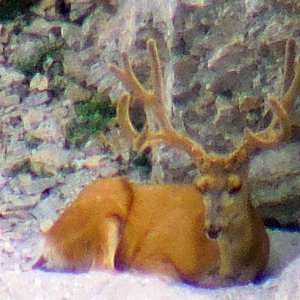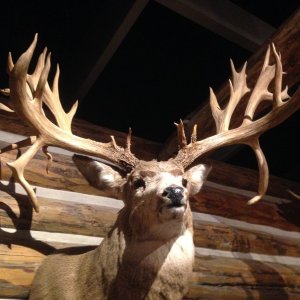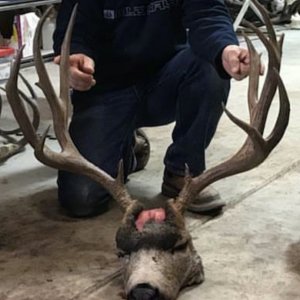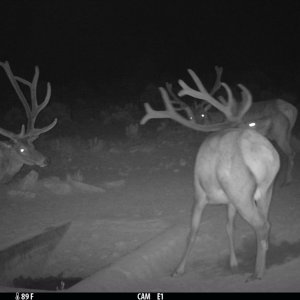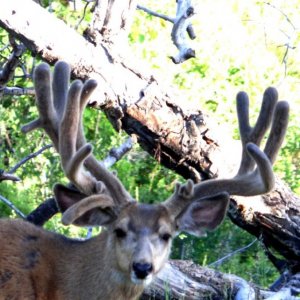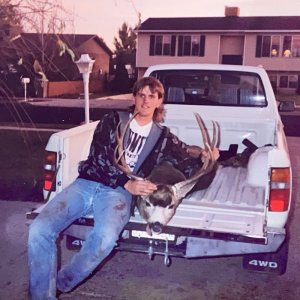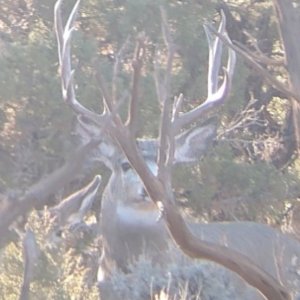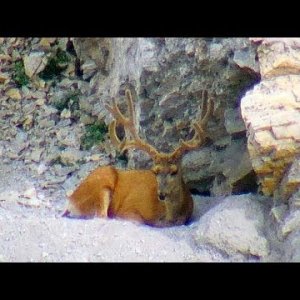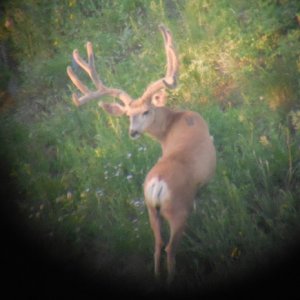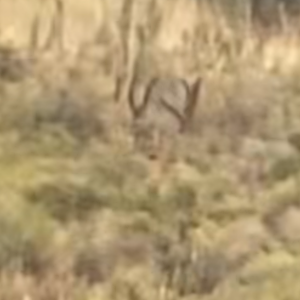Care to share? I don’t subscribe to the trib, and not gonna start but I’m sure curious how I’m involved here?
The following story was reported by The Utah Investigative Journalism Project in partnership with The Salt Lake Tribune.
It was a dream hunt more than 20 years in the making — that’s how long Robert’s father had been applying in annual state drawings for a highly sought after bow hunting tag.
Scoring the tag last year meant Robert and his father would be able to hunt on Heaton Ranch, where Kane County Commissioner Wade Heaton’s outfitting company has touted game “as special and unique as the red rocks canyon and southern Utah terrain they call home.”
The ranch is on the Alton Cooperative Wildlife Management Unit, part of a lucrative program for landowners who get vouchers for big game permits they can sell, typically wrapped with guiding services, for prices that can reach tens of thousands of dollars. Heaton’s Color Country Outfitters auctioned a five-day, guided hunt on the Alton CWMU in 2018 for $90,000.
In exchange, the CWMUs work with the state to manage the wildlife habitat on their property — and they must allow a smaller number of public tag holders to hunt there.
As public hunters, Robert and his father were scouting alone on the Heaton Ranch last August, he said, separate from a larger, private guided group. They were more than a day into their trip, Robert said, when “the next thing we knew, we were caught up in this whole investigation with the Division of Wildlife.”
Subscribe To Top Stories Newsletter
Get the latest news by subscribing to our
Top Stories newsletter. Enter your email below to receive more stories like these right to your inbox.
Subscribe
A DWR investigator questioned them and seized one of his father’s arrows, he said. The experience left them with a “bad taste in their mouth,” he added, so they ended their hunt early.
The division was investigating possible big-game baiting at the Alton CWMU, according to a 62-page report obtained by The Utah Investigative Journalism Project through a public record request.
The report lists Heaton as a suspect — along with six others — and says the division was investigating unlawful big game baiting, unlawful taking/possession of protected wildlife and a pattern of unlawful activity at multiple areas in the Alton CWMU.
At the time, Heaton was a member of the Utah Wildlife Board, which oversees the CWMU program. Five days after the lengthy report was completed on Oct. 4, 2023, Heaton submitted a resignation email to the Division of Wildlife Resources.
”My life has continued to become busier and more complicated,” Heaton wrote, “and I no longer feel that I have the time needed to serve on the Wildlife board.”
(Don Jennings | Southern Utah News) Kane County Commissioner Wade Heaton in 2022.
The division’s investigation was referred in December to the Utah County Attorney’s office to be evaluated for possible charges, according to a DWR spokesperson. The Utah County Attorney’s office did not respond to questions about the status of the case.
Heaton is the operator of the Alton Cooperative Wildlife Management Unit, the division confirmed. Under DWR rules, he could lose the opportunity to operate the CWMU if he is convicted of a wildlife violation. A conviction related to the investigation also could have an impact on the status of the property as a CWMU.
Heaton did not respond to multiple requests for comment. The Utah Investigative Journalism Project and The Salt Lake Tribune are identifying Robert, the public hunter, by a pseudonym because he is listed as a witness, not a suspect, in the report, and he does not want to be publicly connected to possible wildlife violations.
Robert and his father are two of the 11 “involved/others” in the report, which appear to include additional hunters.
‘A buck deer had been shot’
Most of the pages of the released report are blacked out; the division did that because no charges have been filed, a DWR spokesperson explained. The division considers the investigation ongoing, the spokesperson added.
But one of the few unredacted sentences states that at the beginning of the investigation, DWR investigator Mark Ekins “received an email” in mid-August “regarding the unlawful baiting of big game” on property “south of Alton, Utah, in Kane County.”
The report also notes that the initial report was an assertion that “the Alton Cooperative Wildlife Management Unit (CWMU) was baiting big game.”
Days later, on Aug. 26, Ekins and DWR conservation Officer Shane Kitchen went to “an alleged bait site [Ekins] had been investigating on the Paunsaugunt [Plateau] in Kane County,” Kitchen wrote in a supplemental report.
Earlier that day,” Kitchen said, “it was believed that a buck deer had been shot while at the bait site.” In another supplemental report, an officer with a K9 unit said he also had been asked to “locate a buck deer that had been shot but not recovered.”
Kitchen’s report indicates the officers made contact with Wade Heaton, then 50, another man, and Robert’s father. They seized a camera from Heaton and a phone from the other man, the report said.
Baiting big game for hunting only became illegal in Utah in 2021, after all of the state’s immediate neighbors had already banned or restricted it. Baiting is defined as placing food or nutrients to manipulate the behavior of wildlife, and it now can draw charges ranging from a class B misdemeanor to a third-degree felony,
the DWR points out. A conviction can lead to the suspension of hunting privileges.
Robert said he and his father did not shoot a buck, and they didn’t see anyone else shoot a buck while they were at the ranch. They did notice salt licks and water troughs in the areas where they were hunting.
“We asked the outfitters about it three different times and they were like ‘No, the division knows about it,’ and ‘We’ve talked to the division about it and they’re fine with it,’” Robert said.
They deferred to Heaton, Robert said, knowing that he was on the Wildlife Board. “As far as we were concerned, Mr. Heaton is the division,” Robert said.
The 2021 law includes exemptions for salt licks placed by agricultural producers for agriculture purposes. Hunters can hunt over such salt licks, according to DWR.
Heaton Ranch is a cattle ranch that has also invited guests to help with cattle drives, and Robert had taken pictures of cattle in the area where they were hunting.
The unredacted portions of the reports do not specify what the officers were investigating as having been possibly used as bait. Robert acknowledged he did not know the full extent of the investigation.
In the years prior to the ban, the
Heaton Ranch had baited game with apples, according to 2019 reporting by The Tribune. The practice had become increasingly common, especially among bowhunters in southern Utah,
The Tribune reported, because it was effective in luring mule deer to places where concealed hunters could get off a clean shot.
Concerns that baiting could contribute to the spread of infectious diseases in deer herds — and didn’t square with the Western hunting principle of fair chase — helped lead to the ban.
In 2004, Heaton had been
accused of having cornered deer behind an 8-foot fence for a guided hunt. When a cornered animal was caught on a video that was sent anonymously to KSL-TV and shared with regulators, it triggered an investigation into possible illegal trapping.
Heaton told KSL the group of deer had running room but some mistakenly cornered themselves. “I don’t think there was anything illegal that went on with it,” he told the station. “It was too bad. And obviously that’s not the way people like to hunt.”
Ultimately, no charges were filed.
‘You have to keep your nose clean’
DWR explained in a statement that it could not comment on the baiting allegation because it is still under investigation. DWR did stress that Heaton’s status as a former member of the Wildlife Board has not impacted the investigation.
“Regardless of who is being investigated, a conservation officer will investigate the alleged violation and collect any pertinent evidence,” the statement read.
Covey Jones is the wildlife section chief for DWR and previously oversaw the CWMU program as the agency’s private lands coordinator. While not addressing the specifics of Heaton’s case, Jones acknowledged that it can be more difficult to conduct wildlife enforcement on CWMUs compared to public lands, where wildlife law enforcement can move about freely.
(Utah Division of Wildlife Resources) A mule deer on the Alton Cooperative Wildlife Management Unit in Kane County in 2022. Allegations of illegal baiting at the property were investigated in 2023.
With CWMUs, officers may have to coordinate with the landowners to conduct investigations. “Most operators just give you a key for whenever you need to be there,” Jones said.
He also acknowledged that abuses have happened in the past with CWMU operators, but said they have been isolated.
“As a cooperative operator, they are actually agents of the division, so we hold them to a pretty high standard,” Jones said. “If you want to participate in this program you have to keep your nose clean.”
Last year, the CWMU advisory committee recommended banning a CWMU operator from the role for four hunting seasons, after he was charged with taking wildlife while trespassing in Wasatch County and later entered a plea in abeyance to a reduced, attempted version of the misdemeanor. After he met the plea deal’s conditions, the case was dismissed.
The operator had been with a group of hunters who left the CWMU boundaries in 2021 and shot a trophy bull elk 800 yards onto adjacent private property, according to a police report and discussion before the committee.
After any violation of the wildlife code by an operator, committee member Greg Wilding noted, “we are to consider whether the applicant should be approved to participate in the program.”
The CWMU was placed on probation for a year for failing to know and mark its boundaries. The operator’s misconduct was not connected specifically to the operation of the CWMU, since it was managing deer, a police report noted. The elk hunt that day was on the same land, but as private property, the officer explained.
Still, CWMU operators are held to a high standard, committee members agreed. “My thoughts are the operator didn’t live up to a higher standard … the operator should probably be removed,” member Tim Freiss said.
The advisory committee’s recommendation wasn’t forwarded to the Wildlife Board for a final resolution because the operator “agreed to sit out for three years,” the DWR said, and the CWMU engaged a different operator.
‘Wildlife lovers instead of wildlife haters’
Jones said he sees Utah’s CWMU program as “the best public-private partnership for wilderness in the West. It’s awesome.”
In some states, landowners can sell hunting tags without offering anything to the general public, he noted. In other states, private landowners can own thousands of acres of land and not be able to get a deer tag for their own property.
The Utah CWMU requirement that landowners offer access to a small number of hunters who have public tags, he notes, gives average hunters a chance to hunt better lands that ordinarily would be reserved for high-priced guided hunts. According to the DWR, there are 134 CWMUs across the state providing public hunters access to nearly 2.3 million acres they might not otherwise be able to hunt.
While the vouchers for permits that can be sold are lucrative for hunting guides and landowners, those tags don’t bring in more revenue for DWR than general use tags.
According to records from DWR, CWMUs brought just over $7.5 million in revenue from 2019 through 2023 in applications, permit sales and certificates of registration. Over that same period, Heaton’s Alton CWMU brought in $119,156 in revenue to the state.
“We’re focused on herd health, not money,” Jones said.
More benefit goes to the landowners, he said, and keeps them from viewing wildlife on ranches as pests.
“It provides an incentive to not develop that ranch and it maintains higher wildlife populations,” Jones said. “It makes landowners into wildlife lovers instead of wildlife haters.”
When Heaton was young,
he told The Tribune in 2009, “the sentiment among landowners and ranchers was ‘us against the wildlife.’ We hated deer and elk. They destroyed fences and hung out in alfalfa fields.”
After the CWMU program was put in place, he said, “It is kind of amazing to listen to landowners now. They talk about ways to help wildlife thrive on their land and they get really passionate about it.”
Before the state’s ban on baiting was put in place, there were some restrictions on the practice. Utah law, for example, forbid luring bears to a bait station and then pursuing the animal with dogs — as a
guide involved in a hunt with Donald Trump Jr. is accused of doing.
In 2020, The Utah Investigative Journalism Project requested closed investigation records into the guide. The agency had closed the case, but reopened it after the records request was submitted. That resulted in felony wildlife destruction charges being filed against the guide; one charge was dismissed but another is still being litigated.

 www.sltrib.com
www.sltrib.com


